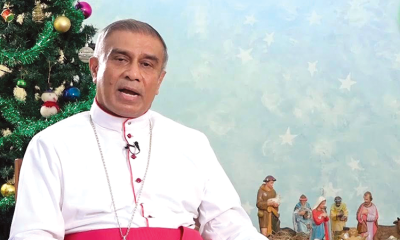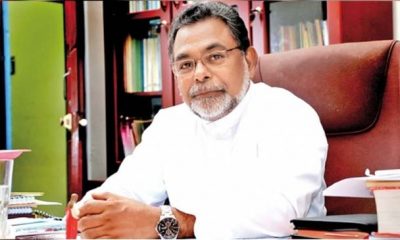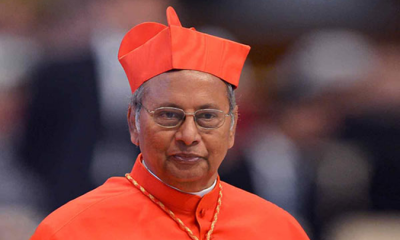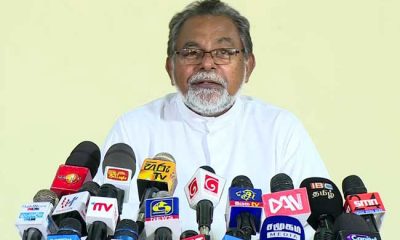Features
Today is the Birthday of the Catholic Church…!

Every one of us has a birthday and so has the Catholic Church! The Birthday of the Holy Mother Church falls today with the Solemnity of the Pentecost.We Catholics believe in a ‘Trinitarian God – the Father, the Son and the Holy Spirit’. The Holy Spirit is understood as the Third Person of the Holy Trinity whose function is to renew and strengthen us in our Journey of Faith.
Pentecost, meaning 50th day in Greek, is celebrated by Christians 50 days after the celebration of Easter, and marks the day that the Holy Spirit descended upon the Apostles while they were cowering and hiding behind locked doors together with Mother Mary following Jesus’ Crucifixion, Death and Resurrection. After receiving the power and the gifts of the Holy Spirit, the Apostles immediately went out and started preaching Jesus’ message to all and sundry – even to those who spoke other languages by making use of the precious gift of tongues!
Pentecost instituted the ‘Age of the Church’, during which Jesus Christ manifests, makes present, and communicates His work of Salvation through His Church, ‘until He Comes again in Glory’.
The Holy Spirit Renews the Church
All true and authentic renewal – renewal in Jesus Christ – is simply a demonstration of the work of the Holy Spirit. Therefore as followers of Christ, we pray for the power of the Holy Spirit and discern the work of the Spirit. This is, always has been, and always will be, the only hope for the growth of the Church making the world a better place. The Church, rightly conceived, exists as a community of believers bound together in the power, presence, and promptings of the Holy Spirit Whose Gifts and Fruits are shared with all humanity.
The Holy Spirit Strengthens the Church
This strengthening of the Church by the Holy Spirit takes place in three basic ways.
First of all, the Holy Spirit strengthens us in our relationship to Jesus Christ.
We already know that the goal of the work of the Holy Spirit is to make us more like Jesus Christ. But how does He do this? It is through a process known as sanctification – making us worthy human beings.
Sanctification is the process of the Holy Spirit stripping away our sinful habits and bringing us into holiness.
Secondly, the Holy Spirit strengthens us in our capacity to defend our faith.
The Holy Spirit empowers Christians to be effective witnesses for Jesus Christ: “But you will receive power when the Holy Spirit comes on you, and you will be my witnesses in Jerusalem, and in all Judea and Samaria, and to the ends of the earth” (Acts 1:8).
The power that the Holy Spirit gives us in this regard is something that reflects in the natural as well as in the supernatural realm. He gives us power, love and self-discipline to stand against all evil.
Thirdly, the strengthening is also in our capacity to spread our faith
. When the love and mercy of Jesus Christ is shared in word and deed throughout the world, it carries out God’s purpose and plan to redeem and restore this fallen and wounded world of ours!
A New Pentecost is What the World Needs Today!
In today’s context of the world, the desire to share the ‘Good News of Love’ should, more than ever before, have a special place in the hearts of all lovers of mankind. The concern to bring others to freedom and salvation should take hold of them and they should step out in bold humanitarian venturesinto this bruised and battered world of ours as messengers of peace. As a result of a revival and renewal, the time has come to boldly proclaim the ‘Message of Peace and Love’, and thereby heal the world with the experience of a ‘New Pentecost’.
We all must, irrespective of religion, take up this present challenge and move forward towards the future with goodwill, hope and perseverance against all the powers of evil and darkness that spread their tentacles all throughout the world in different forms!
Rev. Fr. (Dr.)Eymard Fernando
Catholic Bishop’s House,
Kurunegala.
Features
Removing obstacles to development
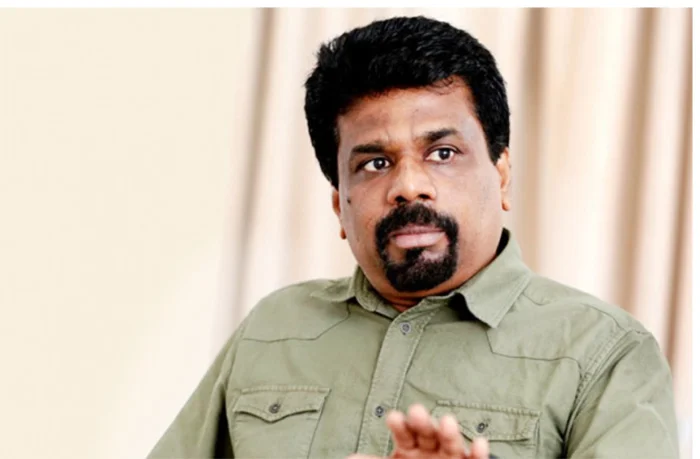
Six months into the term of office of the new government, the main positive achievements continue to remain economic and political stability and the reduction of waste and corruption. The absence of these in the past contributed to a significant degree to the lack of development of the country. The fact that the government is making a serious bid to ensure them is the best prognosis for a better future for the country. There is still a distance to go. The promised improvements that would directly benefit those who are at the bottom of the economic pyramid, and the quarter of the population who live below the poverty line, have yet to materialise. Prices of essential goods have not come down and some have seen sharp increases such as rice and coconuts. There are no mega projects in the pipeline that would give people the hope that rapid development is around the corner.
There were times in the past when governments succeeded in giving the people big hopes for the future as soon as they came to power. Perhaps the biggest hope came with the government’s move towards the liberalisation of the economy that took place after the election of 1977. President J R Jayewardene and his team succeeded in raising generous international assistance, most of it coming in the form of grants, that helped to accelerate the envisaged 30 year Mahaweli Development project to just six years. In 1992 President Ranasinghe Premadasa thought on a macro scale when his government established 200 garment factories throughout the country to develop the rural economy and to help alleviate poverty. These large scale projects brought immediate hope to the lives of people.
More recently the Hambantota Port project, Mattala Airport and the Colombo Port City project promised mega development that excited the popular imagination at the time they commenced, though neither of them has lived up to their envisaged potential. These projects were driven by political interests and commission agents rather than economic viability leading to debt burden and underutilisation. The NPP government would need to be cautious about bringing in similar mega projects that could offer the people the hope of rapid economic growth. During his visits to India and China, President Anura Kumara Dissanayake signed a large number of agreements with the governments of those countries but the results remain unclear. The USD 1 billion Adani project to generate wind power with Indian collaboration appears to be stalled. The USD 3.7 billion Chinese proposal to build an oil refinery also appears to be stalled.
RENEWED GROWTH
The absence of high profile investments or projects to generate income and thereby take the country to a higher level of development is a lacuna in the development plans of the government. It has opened the door to invidious comparisons to be drawn between the new government’s ability to effect change and develop the economy in relation to those in the opposition political parties who have traditionally been in the seats of power. However, recently published statistics of the economic growth during the past year indicates that the economy is doing better than anticipated under the NPP government. Sri Lanka’s economy grew by 5 percent in the year 2024, reversing two years of contraction with the growth rate for the year of 2023 being estimated at negative 2.3 percent. What was particularly creditable was the growth rate for the fourth quarter of 2024 (after the new government took over) being 5.4 percent. The growth figures for the present quarter are also likely to see a continuation of the present trend.
Sri Lanka’s failure in the past has been to sustain its economic growth rates. Even though the country started with high growth rates under different governments, it soon ran into problems of waste and corruption that eroded those gains. During the initial period of President J R Jayawardene’s government in the late 1970s, the economy registered near 8 percent growth with the support of its mega projects, but this could not be sustained. Violent conflict, waste and corruption came to the centre stage which led to the economy getting undermined. With more and more money being spent on the security forces to battle those who had become insurgents against the state, and with waste and corruption skyrocketing there was not much left over for economic development.
The government’s commitment to cut down on waste and corruption so that resources can be saved and added to enable economic growth can be seen in the strict discipline it has been following where expenditures on its members are concerned. The government has restricted the cabinet to 25 ministers, when in the past the figure was often double. The government has also made provision to reduce the perks of office, including medical insurance to parliamentarians. The value of this latter measure is that the parliamentarians will now have an incentive to upgrade the health system that serves the general public, instead of running it down as previous governments did. With their reduced levels of insurance coverage they will need to utilise the public health facilities rather than go to the private ones.
COMMITTED GOVERNMENT
The most positive feature of the present time is that the government is making a serious effort to root out corruption. This is to be seen in the invigoration of previously dormant institutions of accountability, such as the Bribery and Corruption Commission, and the willingness of the Attorney General’s Department to pursue those who were previously regarded as being beyond the reach of the law due to their connections to those in the seats of power. The fact that the Inspector General of Police, who heads the police force, is behind bars on a judicial order is an indication that the rule of law is beginning to be taken seriously. By cost cutting, eliminating corruption and abiding by the rule of law the government is removing the obstacles to development. In the past, the mega development projects failed to deliver their full benefits because they got lost in corrupt and wasteful practices including violent conflict.
There is a need, however, for new and innovative development projects that require knowledge and expertise that is not necessarily within the government. So far it appears that the government is restricting its selection of key decision makers to those it knows, has worked with and trusts due to long association. Two of the committees that the government has recently appointed, the Clean Lanka task force and the Tourism advisory committee are composed of nearly all men from the majority community. If Sri Lanka is to leverage its full potential, the government must embrace a more inclusive approach that incorporates women and diverse perspectives from across the country’s multiethnic and multireligious population, including representation from the north and east. For development that includes all, and is accepted by all, it needs to tap into the larger resources that lie outside itself.
By ensuring that women and ethnic minorities have representation in decision making bodies of the government, the government can harness a broader range of skills, experiences, and perspectives, ultimately leading to more effective and sustainable development policies. Sustainable development is not merely about economic growth; it is about inclusivity and partnership. A government that prioritises diversity in its leadership will be better equipped to address the challenges that can arise unexpectedly. By widening its advisory base and integrating a broader array of voices, the government can create policies that are not only effective but also equitable. Through inclusive governance, responsible economic management, and innovative development strategies the government will surely lead the country towards a future that benefits all its people.
by Jehan Perera
Features
Revisiting Non-Alignment and Multi-Alignment in Sri Lanka’s foreign policy
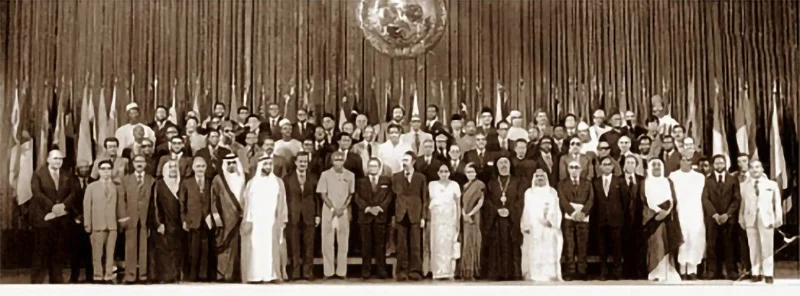
 Former Minister Ali Sabry’s recent op-ed, “Why Sri Lanka must continue to pursue a non-aligned, yet multi-aligned foreign policy,” published in the Daily FT on 3 March, offers a timely reflection on Sri Lanka’s foreign policy trajectory in an increasingly multipolar world. Sabry’s articulation of a “non-aligned yet multi-aligned” approach is commendable for its attempt to reconcile Sri Lanka’s historical commitment to non-alignment with the realities of contemporary geopolitics. However, his framework raises critical questions about the principles of non-alignment, the nuances of multi-alignment, and Sri Lanka’s role in a world shaped by great power competition. This response seeks to engage with Sabry’s arguments, critique certain assumptions, and propose a more robust vision for Sri Lanka’s foreign policy.
Former Minister Ali Sabry’s recent op-ed, “Why Sri Lanka must continue to pursue a non-aligned, yet multi-aligned foreign policy,” published in the Daily FT on 3 March, offers a timely reflection on Sri Lanka’s foreign policy trajectory in an increasingly multipolar world. Sabry’s articulation of a “non-aligned yet multi-aligned” approach is commendable for its attempt to reconcile Sri Lanka’s historical commitment to non-alignment with the realities of contemporary geopolitics. However, his framework raises critical questions about the principles of non-alignment, the nuances of multi-alignment, and Sri Lanka’s role in a world shaped by great power competition. This response seeks to engage with Sabry’s arguments, critique certain assumptions, and propose a more robust vision for Sri Lanka’s foreign policy.
Sabry outlines five key pillars of a non-aligned yet multi-aligned foreign policy:
- No military alignments, no foreign bases: Sri Lanka should avoid entangling itself in military alliances or hosting foreign military bases.
- Economic engagement with all, dependency on none
: Sri Lanka should diversify its economic partnerships to avoid over-reliance on any single country.
* Diplomatic balancing
: Sri Lanka should engage with multiple powers, leveraging relationships with China, India, the US, Europe, Japan, and ASEAN for specific benefits.
- Leveraging multilateralism
: Sri Lanka should participate actively in regional and global organisations, such as UN, NAM, SAARC, and BIMSTEC.
- Resisting coercion and protecting sovereignty
: Sri Lanka must resist external pressures and assert its sovereign right to pursue an independent foreign policy.
While pillars 1, 2, and 5 align with the traditional principles of non-alignment, pillars 3 and 4 warrant closer scrutiny. Sabry’s emphasis on “diplomatic balancing” and “leveraging multilateralism” raises questions about the consistency of his approach with the spirit of non-alignment and whether it adequately addresses the challenges of a multipolar world.
Dangers of over-compartmentalisation
Sabry’s suggestion that Sri Lanka should engage with China for infrastructure, India for regional security and trade, the US and Europe for technology and education, and Japan and ASEAN for economic opportunities reflects a pragmatic approach to foreign policy. However, this compartmentalisation of partnerships risks reducing Sri Lanka’s foreign policy to a transactional exercise, undermining the principles of non-alignment.
Sabry’s framework, curiously, excludes China from areas like technology, education, and regional security, despite China’s growing capabilities in these domains. For instance, China is a global leader in renewable energy, artificial intelligence, and 5G technology, making it a natural partner for Sri Lanka’s technological advancement. Similarly, China’s Belt and Road Initiative (BRI) offers significant opportunities for economic development and regional connectivity. By limiting China’s role to infrastructure, Sabry’s approach risks underutilising a key strategic partner.
Moreover, Sabry’s emphasis on India for regional security overlooks the broader geopolitical context. While India is undoubtedly a critical partner for Sri Lanka, regional security cannot be addressed in isolation from China’s role in South Asia. The Chinese autonomous region of Xizang (Tibet) is indeed part of South Asia, and China’s presence in the region is a reality that Sri Lanka must navigate. A truly non-aligned foreign policy would seek to balance relationships with both India and China, rather than assigning fixed roles to each.
Sabry’s compartmentalisation of partnerships risks creating silos in Sri Lanka’s foreign policy, limiting its flexibility and strategic depth. For instance, by relying solely on the US and Europe for technology and education, Sri Lanka may miss out on opportunities for South-South cooperation with members of BRICS.
Similarly, by excluding China from regional security discussions, Sri Lanka may inadvertently align itself with India’s strategic interests, undermining its commitment to non-alignment.
Limited multilateralism?
Sabry’s call for Sri Lanka to remain active in organisations like the UN, NAM, SAARC, and BIMSTEC is laudable. However, his omission of the BRI, BRICS, and the Shanghai Cooperation Organisation (SCO) is striking. These platforms represent emerging alternatives to the Western-dominated global order and offer Sri Lanka opportunities to diversify its partnerships and enhance its strategic autonomy.
The BRI is one of the most ambitious infrastructure and economic development projects in history, involving over 140 countries. For Sri Lanka, the BRI offers opportunities for infrastructure development, trade connectivity, and economic growth. By participating in the BRI, Sri Lanka can induce Chinese investment to address its infrastructure deficit and integrate into global supply chains. Excluding the BRI from Sri Lanka’s foreign policy framework would be a missed opportunity.
BRICS and the SCO represent platforms for South-South cooperation and multipolarity. BRICS, in particular, has emerged as a counterweight to such Western-dominated institutions as the IMF and World Bank, advocating for a more equitable global economic order. The SCO, on the other hand, focuses on regional security and counterterrorism, offering Sri Lanka a platform to address its security concerns in collaboration with major powers like China, Russia, and India. By engaging with these organisations, Sri Lanka can strengthen its commitment to multipolarity and enhance its strategic autonomy.
Non-alignment is not neutrality
Sabry’s assertion that Sri Lanka must avoid taking sides in major power conflicts reflects a misunderstanding of non-alignment. Non-alignment is not about neutrality; it is about taking a principled stand on issues of global importance. During the Cold War, non-aligned countries, like Sri Lanka, opposed colonialism, apartheid, and imperialism, even as they avoided alignment with either the US or the Soviet Union.
Sri Lanka’s foreign policy, under leaders like S.W.R.D. Bandaranaike and Sirimavo Bandaranaike, was characterised by a commitment to anti-colonialism and anti-imperialism, opposing racial segregation and discrimination in both its Apartheid and Zionist forms. Sri Lanka, the first Asian country to recognise revolutionary Cuba, recognised the Palestine Liberation Organisation (PLO) and the Provisional Revolutionary Government of South Vietnam, supported liberation struggles in Africa, and opposed the US military base in Diego Garcia. These actions were not neutral; they were rooted in a principled commitment to justice and equality.
Today, Sri Lanka faces new challenges, including great power competition, economic coercion, and climate change. A truly non-aligned foreign policy would require Sri Lanka to take a stand on issues like the genocide in Gaza, the colonisation of the West Bank, the continued denial of the right to return of ethnically-cleansed Palestinians and Chagossians, the militarisation of the Indo-Pacific, the use of economic sanctions as a tool of coercion, and the need for climate justice. By avoiding these issues, Sri Lanka risks becoming the imperialist powers’ cringing, whingeing client state.
The path forward
Sabry’s use of the term “multi-alignment” reflects a growing trend in Indian foreign policy, particularly under the BJP Government. However, multi-alignment is not the same as multipolarity. Multi-alignment implies a transactional approach to foreign policy, where a country seeks to extract maximum benefits from multiple partners without a coherent strategic vision. Multipolarity, on the other hand, envisions a world order where power is distributed among multiple centres, reducing the dominance of any single power.
Sri Lanka should advocate for a multipolar world order that reflects the diversity of the global South. This would involve strengthening platforms like BRICS, the SCO, and the NAM, while also engaging with Western institutions like the UN and the WTO. By promoting multipolarity, Sri Lanka can contribute to a more equitable and just global order, in line with the principles of non-alignment.
Ali Sabry’s call for a non-aligned, yet multi-aligned foreign policy falls short of articulating a coherent vision for Sri Lanka’s role in a multipolar world. To truly uphold the principles of non-alignment, Sri Lanka must:
* Reject compartmentalisation
: Engage with all partners across all domains, including technology, education, and regional security.
* Embrace emerging platforms
: Participate in the BRI, BRICS, and SCO to diversify partnerships and enhance strategic autonomy.
* Take principled stands
: Advocate for justice, equality, and multipolarity in global affairs.
* Promote South-South cooperation
: Strengthen ties with other Global South countries to address shared challenges, like climate change and economic inequality.
By adopting this approach, Sri Lanka can reclaim its historical legacy as a leader of the non-aligned movement and chart a course toward a sovereign, secure, and successful future.
(Vinod Moonesinghe read mechanical engineering at the University of Westminster, and worked in Sri Lanka in the tea machinery and motor spares industries, as well as the railways. He later turned to journalism and writing history. He served as chair of the Board of Governors of the Ceylon German Technical Training Institute. He is a convenor of the Asia Progress Forum, which can be contacted at asiaprogressforum@gmail.com.)
by Vinod Moonesinghe
Features
Nick Carter …‘Who I Am’ too strenuous?

 Cancellation of shows has turned out to be a regular happening where former Backstreet Boys Nick Carter is concerned. In the past, it has happened several times.
Cancellation of shows has turned out to be a regular happening where former Backstreet Boys Nick Carter is concerned. In the past, it has happened several times.
If Nick Carter is not 100 percent fit, he should not undertake these strenuous world tours, ultimately disappointing his fans.
It’s not a healthy scene to be cancelling shows on a regular basis.
In May 2024, a few days before his scheduled visit to the Philippines, Carter cancelled his two shows due to “unforeseen circumstances.”
The promoter concerned announced the development and apologised to fans who bought tickets to Carter’s shows in Cebu, on May 23, and in Manila, on May 24.
The dates were supposed to be part of the Asian leg of his ‘Who I Am’ 2024 tour.
Carter previously cancelled a series of solo concerts in Asia, including Jakarta, Mumbai, Singapore, and Taipei. And this is what the organisers had to say:
“Due to unexpected matters related to Nick Carter’s schedule, we regret to announce that Nick’s show in Asia, including Jakarta on May 26 (2024), has been cancelled.
His ‘Who I Am’ Japan tour 2024 was also cancelled, with the following announcement:

Explaining, on video, about the
cancelled ‘Who I Am’ shows
“We regret to announce that the NICK CARTER Japan Tour, planned for June 4th at Toyosu PIT (Tokyo) and June 6th at Namba Hatch (Osaka), will no longer be proceeding due to ‘unforeseen circumstances.’ We apologise for any disappointment.
Believe me, I had a strange feeling that his Colombo show would not materialise and I did mention, in a subtle way, in my article about Nick Carter’s Colombo concert, in ‘StarTrack’ of 14th January, 2025 … my only worry (at that point in time) is the HMPV virus which is reported to be spreading in China and has cropped up in Malaysia, and India, as well.
Although no HMPV virus has cropped up, Carter has cancelled his scheduled performance in Sri Lanka, and in a number of other countries, as well, to return home, quoting, once again, “unforeseen circumstances.”
“Unforeseen circumstances” seems to be his tagline!
There is talk that low ticket sales is the reason for some of his concerts to be cancelled.
Yes, elaborate arrangements were put in place for Nick Carter’s trip to Sri Lanka – Meet & Greet, Q&A, selfies, etc., but all at a price!
Wonder if there will be the same excitement and enthusiasm if Nick Carter decides to come up with new dates for what has been cancelled?
-
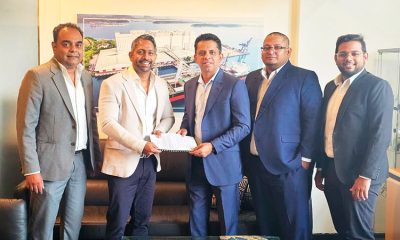
 Business5 days ago
Business5 days agoCargoserv Shipping partners Prima Ceylon & onboards Nestlé Lanka for landmark rail logistics initiative
-
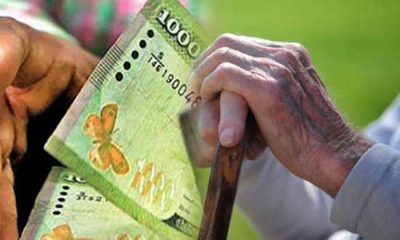
 News3 days ago
News3 days agoSeniors welcome three percent increase in deposit rates
-

 Features3 days ago
Features3 days agoThe US, Israel, Palestine, and Mahmoud Khalil
-
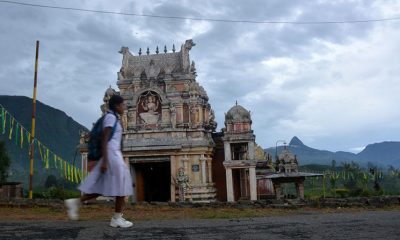
 News3 days ago
News3 days agoScholarships for children of estate workers now open
-

 Business5 days ago
Business5 days agoSri Lankans Vote Dialog as the Telecommunication Brand and Service Brand of the Year
-
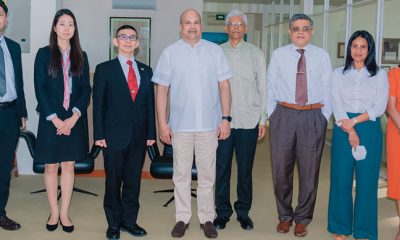
 News4 days ago
News4 days agoDefence Ministry of Japan Delegation visits Pathfinder Foundation
-

 Features5 days ago
Features5 days agoThe Vaping Veil: Unmasking the dangers of E-Cigarettes
-

 News5 days ago
News5 days ago‘Deshabandu is on SLC payroll’; Hesha tables documents


